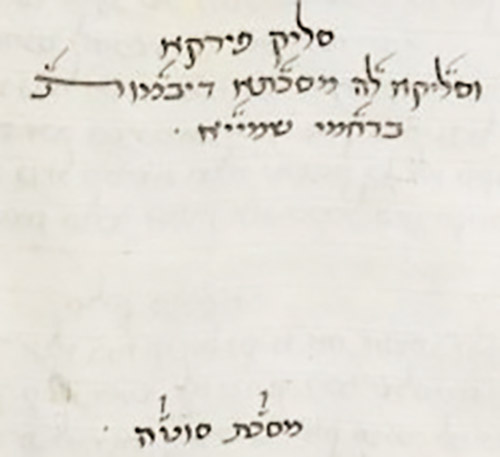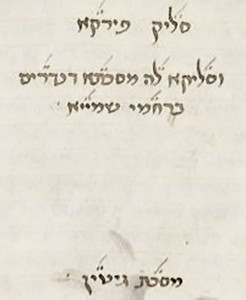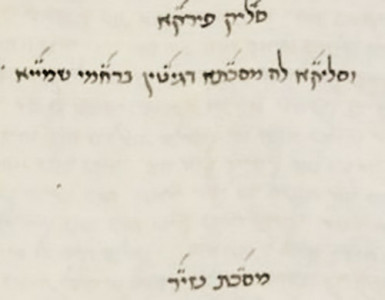
What is Nazir doing in seder Nashim? The Talmudic Narrator opens the tractate by asking this curious question. מִכְּדֵי תַּנָּא בְּסֵדֶר נָשִׁים קָאֵי, מַאי טַעְמָא תָּנֵי נָזִיר? If the tanna of our Mishnah was working within the order of Nashim, women, why suddenly discuss the laws of nazir (a person who voluntarily vowed to live a strict and holy lifestyle)? The answer is that the tanna was focused on the verse which mentions divorce because of the husband finding עֶרְוַת דָּבָר, an unseemly manner, i.e. adultery. And what caused the sin? Wine. And the tanna is effectively stating, “anyone who sees a sotah in her disgrace should abstain (יַזִּיר עַצְמוֹ) from wine.”
The answer of תַּנָּא אַקְּרָא קָאֵי finds its parallel in Berachot 2a, explaining the Mishnah’s author beginning with the evening Shema based on biblical focus. But the best parallel for the entire discussion is Sotah 2a. There, in expansive language, we discover a brayta. Rabbi (Yehuda HaNasi) says, “Why is the Torah portion (in Bamidbar 6) juxtaposed with the Torah portion (Bamidbar 5) of sotah? To tell you that anyone who sees a sotah in her disgrace should abstain from wine.” We thus know which tanna said it, and know that it isn’t mere logic, but biblical interpretation. Indeed, Rabbi Yehuda HaNasi redacted the Mishnayot, and he’s simply following his own derasha1.
I’m somewhat unhappy with the Gemara’s purported question, why Nazir is placed in Nashim. Of course Nazir belongs in Nashim! We may mistakenly think that the grouping principle of these tractates is that they involve women. After all, the masechtot are Yevamot, Ketubot, Nedarim, Nazir, Sotah, Gittin and Kiddushin, many of which are woman-oriented. However, challah, niddah (family purity) and hadlakot neirot (lighting candles) are entrusted specifically to women, and those masechtot and the perek of Bameh Madlikin appear in the orders of Zeraim, Taharot and Moed, though presumably due to a different grouping principle. Furthermore, Nedarim is also present2.

Mayhaps Nashim would be better titled Kinyanim and Kabbalot, acquisitions and acceptances. The focus is how, through action, or the written or spoken word, a person can create binding legal reality. Thus, the first chapter of Kiddushin not only details the way a woman can enter or leave marriage, but also how a Hebrew or Canaanite slave can be acquired or freed, and how an animal or real estate can be acquired. Ketubot involves accepting binding financial obligations on oneself. Gittin deals not only with how the woman leaves marriage, but how she acquires the bill of divorce. Yevamot involves yibbum and chalizah, means of changing status by action. For sotah, the husband’s jealous declaration before witnesses changes the woman’s status. Nedarim and nazir involve verbal acts combining with gemirat daat (seriousness of intent) to create legally binding prohibitions on yourself or others. I’m surprised that Shevuot is grouped in Nezikin. Though Shevuot deals not only with binding oaths that something must happen, but oaths about the fact that something has happened, biblically or rabbinically imposed, on the claims appearing in Nezikin.
Variant and Parallel Texts
Indeed, I’m not sure that this was actually the Talmudic Narrator’s question in Nazir. Alas, I have no nice pictures of variant manuscripts to show you this time. My evidence is the Talmudic commentators who explain that this is indeed the Talmudic Narrator’s question. Our printed Gemara reads מִכְּדֵי תַּנָּא בְּסֵדֶר נָשִׁים קָאֵי, מַאי טַעְמָא תָּנֵי נָזִיר? Pseudo-Rashi writes מ”ט תני נזיר – דמאי איריא מילי דנזיר בסדר נשים. That is, he quotes the second part of the statement, “Why did he teach Nazir,” and explains the question as “What are matters of Nazir doing in Nashim?” So too, Tosafot: מאי טעמא תני נזיר – פירוש בסדר נשים בסדר קדשים הוה ליה למיתנייה. The only reason they need to explain that the concern is which order it appears, and that it seems tangential in Nashim, is because the Gemara itself didn’t state it. In contrast, Rosh does quote the text as in our printed Gemara. If so, we might consider what the question means in Sotah, where תַּנָּא בְּסֵדֶר נָשִׁים קָאֵי doesn’t appear; Sotah fits quite well in Nashim. Rather, the question is how Sotah (or Nazir) fits in the sequence of tractates.

Indeed, Meiri takes note of the following girsa in Nazir 2a: מִכְּדֵי תַּנָּא מֵעֶגְלָה עֲרוּפָה קָא סְלִיק. “Let us see: the tanna is leaving from eglah arufa,” discussed in the final Mishnayot of Sotah. Meiri then notes that in Sotah, after referencing the brayta where Rabbi interprets the biblical juxtaposition, the Gemara asks, if so, let it teach Sotah and then Nazir! (The Gemara in Sotah addresses that inversion, that first, there was Ketubot, which discussed הַמַּדִּיר אֶת אִשְׁתּוֹ – in the seventh perek, even though several perakim follow; that naturally led to Nedarim; which naturally led to Nazir; and from there to Sotah.) Regardless, this is a contradiction in the sequence of tractates, as to whether Sotah precedes Nazir or vice versa. Therefore, Meiri believes the girsa is as we have it, questioning why Nazir is in Nashim.
I suspect that the original girsa in Nazir is rather the shortest version, as Pseudo-Rashi and Tosafot have it, and different hands, or scribes or marginal glosses, expanded it to refer either to eglah arufa (not realizing the inversion or having a different tradition as to sequence) or to seder Nashim. In Nazir, the free-association from עֶרְוַת דָּבָר makes me suspect that the preceding masechta may have even been Gittin.
As to the actual sequence, different traditions may well have developed across time and space. The general pattern is that within each order, the tractates appear in descending order by number of chapters. So, we have Yevamot (16), Ketubot (13), Nedarim (11), Nazir (9), Sotah (9), Gittin (9) and Kiddushin (4). Inverting any of the nines would preserve the descending order. On Sefaria for Yerushalmi, Sotah is placed between Yevamot and Ketubot. In the complete Leiden Yerushalmi manuscript, aside from that, Gittin is indeed placed between Nedarim and Nazir, thus justifying the “ervat davar” lead-in.
In sum, I’d guess that the Talmudic Narrator first posed the question in Sotah, where the most complete material appears. This sugya was then transferred to the other most-relevant location, Nazir, in shortened form. Then, depending on commentators’ interpretations, and depending on tractate sequencing, the suyot further developed to reference the order of Nashim, the preceding eglah arufah, the preceding and inverted Nazir or the preceding Gittin.
Rabbi Dr. Joshua Waxman teaches computer science at Stern College for Women, and his research includes programmatically finding scholars and scholastic relationships in the Babylonian Talmud.
1. While Sotah 2a is the primary sugya vis-à-vis Nazir 2a, the Talmudic Narrator in Sotah, who says כִּדְרַבִּי דְּתַנְיָא רַבִּי אוֹמֵר, is harnessing a brayta whose primary location is Berachot 63a, where a corpus of Tannaitic sources involving Rabbi Yehuda HaNasi or juxtaposed verses occurs.
2. We can argue Nedarim is dragged along with Nazir, as well as having significant portions dealing with a man nullifying his daughter or wife’s vow. Similarly, a woman can be a nazir, as Bemidbar 6:2 states, אִ֣ישׁ אֽוֹ־אִשָּׁ֗ה כִּ֤י יַפְלִא֙ לִנְדֹּר֙ נֶ֣דֶר נָזִ֔יר.









